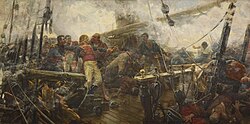The Municipality of San REMIGIO celebrates the LAPYAHAN
Festival in cognizance of the Town Fiesta. Lapyahan means shoreline, symbolized
the arrival of the development and progress in the midst of this proud town
after a long wait, when then it’s a venue of community where posted to guard
the town or a stronghold when the Moro depredators were sighted. Laterally
LAPYAHAN describes the unique feature of San Remigio for having the longest
shoreline in Cebu Province with ala Boracay white beaches enough to taunt
foreign and local tourists.
The theme of this festival is a combination of Town’s
History and God’s gift natural beautiful shoreline. The first section of the
festivity is history, the ritual dance chronologically symbolize from the very
beginning from pre Spanish era, Japanese occupation then to American regime
until the independence of what we are now.
In support of the nature we are exploring the synergy of
agro- forestry and eco-tourism down to the shoreline. The dancer show how the
farmers in upland area preserve the ecosystem from the mountain all the way to
the shoreline up to the coral reef with the collaboration of the fishermen
without damaging the nature but still maintain their economic activities to
support the eco-tourism.
The costume and props use by the upland section, camouflage
their motive of promoting the agro-forestry product to the low land community.
Another concept of the farmers which they are going to portray is the products
of agro-forestry system that are being sold to the shoreline community and the
tourist market- like organic foods and ornamentation and made of variety crafts
for souvenir item that come from the indigenous materials or recycle one. To
sum up the people in the mountain have also a role to follow the flow of
eco-system.
The props and costumes used by
the dancers in coastal area still camouflage on how the cycle of deforestation,
soil erosion and the greatest and the most damaging problem to the sea
resources which is the siltation. The sea section to the line in the
preservation of the marine resources as not to damage the productivity and
diversity has allow the low land people to live comfortably along the LAPYAHAN;
will be protected from strong sea currents and waves, and allow them to harvest
a bountiful fish product and other marine life. The creativity of the
dancer show how the pollution coming from the upland area down to the sea, that
damage the coral reef by dirtying the sea bed.
After all segments of
presentation, the upland and coastal community should be able to show how to
sustain the momentum of their currently positively efforts in the environmental
rehabilitation and protection to support to our eco-system cycle of the area.
This also enables the local people both upland and low land to utilize the
manner that will ensure the sustained used of resources for future generation.
The conceptualization of the
festival is similar to the shoreline act as the last point of the destination
of the waves as connection between the sea and the dry land, in which the
dancers story line concepts, movement vocabulary and floor pattern adhere the
history and cultural roots of the people.
At the end we hope that the conceptualization of the theme,
motif and the concept of this festival will spur the conversion of natural
resources of this municipality as eco-tourism hub of Cebu North. So come and
celebrate with us and appreciate the beauty of LAPYAHAN if only protected and
the freshness of agro-forestry and marine products and watch the beautiful
sunset along the shores of Tañon Strait.

































































